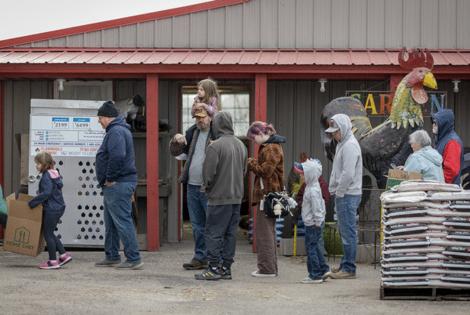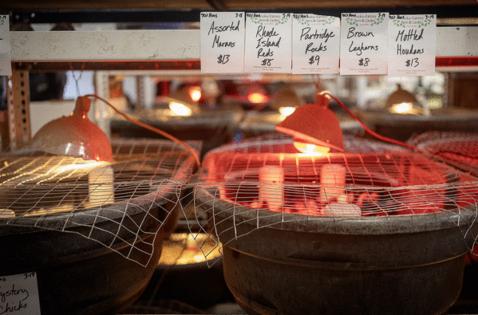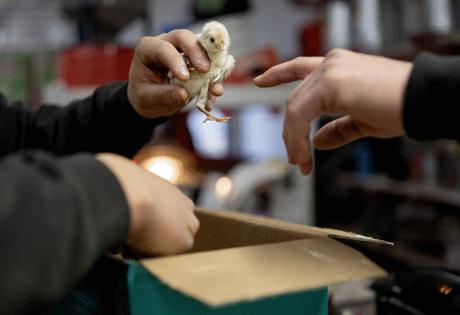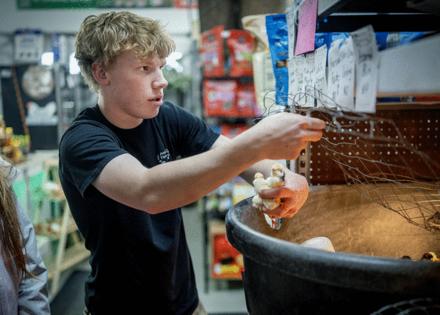After record high egg prices, some race to buy backyard chickens
Published in Lifestyles
MINNEAPOLIS -- Chicks have been flying off the shelves — figuratively, of course.
After a recent nationwide spike in egg prices, local agriculture stores have seen a surge in demand for chickens as Twin Cities residents rush to establish their own backyard coops.
Last Friday morning, around 100 customers hoping to buy baby chicks lined up outside of Anoka Ramsey Farm & Garden beginning at 6 a.m. — three hours before the store’s opening.
Within two hours of letting customers in, 1,000 chickens were sold.
Tom Tidrick, owner of Anoka Ramsey Farm & Garden, said he’s never seen a year like this in his 45 years of business. This has been the feed and supply store’s biggest year selling chickens, which Tidrick said he thought was partly due to the bird flu and the resulting nationwide egg shortage.
“Part of it is the increase in the interest in backyard chickens, I believe, and then the other half is probably the egg shortage,” Tidrick said. “You get a shortage in the stores, people begin to panic and then they want their own eggs.”
A backyard boom
Since the beginning of the year, egg prices have soared due to the widespread bird flu outbreak that has infected millions of egg-laying chickens. In February, wholesale prices of large white eggs rose to $8.42 per dozen in the Midwest, according to the U.S. Department of Agriculture. The high prices pushed Keys Cafe & Bakery restaurants across the Twin Cities to add a temporary 50-cent surcharge for each egg and have forced consumers to look for ways to cut grocery costs.
However, recent data from the Department of Agriculture indicates a decrease in egg prices, noting the Midwest wholesale price for large white eggs is now $5.07 per dozen.
Still, even though wholesale egg prices are decreasing, it may be a while before consumers see significant price drops in grocery stores, especially as egg demand remains high with the Easter holiday around the corner.
Some stores have continued to limit the number of cartons customers can purchase. A similar limitation has now been extended to live poultry.
Anoka Ramsey Farm & Garden has a 10-chicken purchase limit for customers during walk-ins on Fridays. There is no limit for pre-orders.
Tidrick said the store hopes to continue selling chicks throughout the summer, but he only has them pre-ordered from their primary hatchery, Hoover’s Hatchery, through May 2. Despite sending the pre-ordered chicks, Hoover’s has been unreachable.
“It’s very lucky that we ordered when we did back at Christmas because we’ve been cut off from our hatchery now, as has everybody,” Tidrick said. “Our chick lady hasn’t spoken with them for six weeks. They won’t answer our calls, our rep won’t return calls, it’s a mess.”
Hoover’s Hatchery did not respond to a request for comment.
Dr. Shauna Voss, assistant director of the Minnesota Board of Animal Health, said she’s heard many reports from stores that sell chicks within the state that are having a difficult time obtaining birds because of high demand.
The surge is partially driven by recently high egg prices, but also by a growing interest in backyard chicken keeping as a hobby, according to Voss. While interest spiked during the COVID-19 pandemic, it has remained strong in the years since, with current demand once again on the rise.
Prices of chicken supplies add up
Hens usually begin laying eggs around six months old and can continue to lay for five to ten years, making owning and caring for them a long-term investment.
Voss said that while owning chickens can be a hobby, it is not necessarily a cost-effective method for saving money on eggs.
Chickens themselves are often very affordable, and shoppers can purchase them from local farmers or tractor-supply stores for under $10. But chicken coops and feed can be costly. Coop prices range from a “do it yourself” enclosure built for a few hundred dollars to larger fancier coops priced at more than $1,000. A 50-pound bag of feed costs around $30, with a flock of six running through about a bag a month.
Sabrina Florentino, the alternate livestock system extension educator at the University of Minnesota, said baby birds will require extra care, including supplemental heat through heat lamps.
Emma Krell, of Nowthen, Minn., has raised chickens for more than five years and advises new keepers to research costs and management thoroughly, noting the initial high setup costs and ongoing expenses like feed and bedding.
“It’s definitely pricey getting into it,” Krell said. “But once you have an established flock, I think it evens out a little bit.”
Biosecurity measures play crucial role
Florentino said taking appropriate health measures is important when raising birds, noting education is necessary for responsible poultry ownership.
“Thinking about biosecurity is probably the number one thing I would want people to have in their mind right now, even if we are not in the middle of avian influenza,” Florentino said. “There’s other diseases to consider.”
The Minnesota Board of Animal Health teaches basic biosecurity measures such as using dedicated clothing and footwear when working with the birds, keeping their feed and water supplies fresh, and not letting wild birds or other animals have any access to their food or water.
Monitoring bird health is another important task, including looking for signs of disease and working with a veterinarian to try to get a diagnosis and appropriate treatment measures, Voss said.
Molly Lunaris, director of St. Paul Animal Control, advised people considering getting chickens this spring to call local veterinarians to see if their new pets will be supported and to check in with their city for permit requirements.
Households must comply with city ordinances to serve as a chicken home base. Permits and restrictions vary by city, but there is generally an initial permit cost and annual renewal fee.
For new flock owners interested in educational resources, Tidrick teaches multiple classes on raising backyard chickens for beginners through Anoka-Hennepin School District.
The University of Minnesota Extension also provides resources on raising small-scale and backyard poultry on their website and YouTube channel.
____
Louis Krauss of the Minnesota Star Tribune contributed to this story.
____
©2025 The Minnesota Star Tribune. Visit at startribune.com. Distributed by Tribune Content Agency, LLC.































Comments